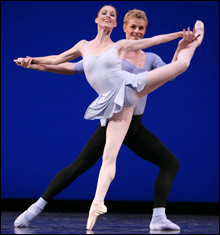Pacific Northwest Ballet and Choreftes at JP, plus BB 2006 – 2007 and a DVD surprise
By JEFFREY GANTZ | August 23, 2006

DUO CONCERTANT I: Louise Nadeau and Olivier Wevers had the body language but not the facial expression. |
All summer long I’ve had the phrase “Do the Lambarena” running through my head, as if it were a dance craze, like the la-dee-dah or the lambada. It’s actually a suite of pieces assembled by Pierre Akendengué and Hughes de Courson that, taking its name from the town in Gabon where Albert Schweitzer founded a hospital in 1913, fuses Schweitzer’s beloved Bach — but why so many Passion selections? — with West African rhythms. In 1995, Val Caniparoli drew on that score to create for San Francisco Ballet a dance of the same name, in which men hunt, women carry, and there’s a Crucifixion scene to the Agnus Dei from the B-minor Mass. Boston Ballet staged it last March: the Times’ John Rockwell liked it, the Boston critics didn’t, audiences were divided as to whether it was an authentic African experience or just a tourist visit.I wondered what Caniparoli’s work would look like on a less white company — specifically Alvin Ailey American Dance Theater. It was, however, Pacific Northwest Ballet, under new director (and former New York City Ballet principal) Peter Boal, that brought Lambarena to Jacob’s Pillow last week, and it turned out that PNB is even whiter, an entire company of Karine Senecas, the Boston Ballet principal who in the lead female role conjured a white woman in Africa not trying to be anything else. Seneca at least had some elegance; PNB’s Ariana Lallone was stiff-bodied, only her arms and her head in any kind of locomotion, and in his solo Olivier Wevers could have been auditioning for a Jan & Dean video. Clarisse Mouassi’s singing of the opening “Sankanda” is so kinetic that the absence of swivelhips on stage can’t spoil it, and the combination of “Ruht wohl ihr heiligen Gebeine” (from the St. John Passion) with handclaps and a precentor’s invocations to the dead and the living and some disquieting animal movement from Caniparoli is hard to shake. Lambarena also looked less ambitious, and less pretentious, on the smaller Pillow stage than it did at the Wang Theatre. But it still has “Whiteboy visits Africa with Berlitz and Baedeker” written all over it.
Pacific Northwest Ballet also brought company ballet master Paul Gibson’s The Piano Dance, PNB choreographers’-showcase contributor Sonia Dawson’s Ripple Mechanics, and George Balanchine’s Duo Concertant. This last, choreographed for NYCB’s 1972 Stravinsky Festival to a duo for violin and piano that Igor composed in 1932, puts the musicians downstage right and has the two dancers stand alongside and listen to the first section, Balanchine’s way of saying that it all starts with the music. Marjorie Kransberg-Talvi’s violin sounded a little muddy; Louise Nadeau and Olivier Wevers, meanwhile, looked on with frozen smiles straight out of The Lawrence Welk Show, and when they started dancing, they kept grinning at the audience and hardly looked at each other, as if to say, “No sex, please, we’re . . . Balanchine dancers?” Hard to believe that Boal, who was not only a principal at NYCB but a very good one, doesn’t know better. And such a waste: Nadeau from the neck down was exemplary, at once available and unavailable, her pelvis saying yes as her eyes said no, and Wevers had everything except an intelligent expression.
 Related
Related:
L’Allegro, fuss and feathers, and the ICA blues, Moonbeams, Dark victory, More 
- L’Allegro, fuss and feathers, and the ICA blues
This year we were looking forward to dance performances at the Barbara Lee Family Foundation Theater in the new ICA.
- Moonbeams
Shakespeare’s A Midsummer Night’s Dream is a dizzy dance of a drama, meandering mystifyingly between May Eve and Midsummer Eve under a moon that goes from new to full swifter than arrow from the Tartar’s bow.
- Dark victory
It’s a good pairing: together, Serenade and La Sylphide write an essay on doomed love
- Dreaming and remembrance
Two momentous revivals in town showed us how big the category of classical ballet really is.
- Theme and variations
George Balanchine was famous for “non-story” ballets, but when you put three of his works — the usual number to fill up an evening — together, you always get some kind of narrative.
- State of the art
Maybe it’s the economy, but Boston Ballet’s third-annual season-opening gala was a sober evening, without the orchestral overture that graced the first two affairs.
- Happy returns
George Balanchine didn’t go in for productions of the old classic ballets.
- Sparring with the Ultimate
There’s never been a more brilliant exemplar of the ballet art than George Balanchine.
- New Orleans story
When the Royal Ballet touches down at the Wang Theatre this month, quash any visions you might have of tea-and-crumpets decorum.
- Dancing across the city
The ICA’s Barbara Lee Family Foundation Theater, with its sprung wood dance floor and wrap-around windows framing the harbor, is positioned to become Boston dance’s most significant venue.
- Slideshow: Boston Ballet's Jewels
Photos from George Balanchine's Jewels, performed by the Boston Ballet.
- Less

 Topics
Topics:
Dance
, Entertainment, Science and Technology, Rie Ichikawa, More  , Entertainment, Science and Technology, Rie Ichikawa, Ballet Theatre Foundation Inc., Carlos Molina, Erica Cornejo, Doris Duke, John Rockwell, Soft Drinks, Val Caniparoli, Less
, Entertainment, Science and Technology, Rie Ichikawa, Ballet Theatre Foundation Inc., Carlos Molina, Erica Cornejo, Doris Duke, John Rockwell, Soft Drinks, Val Caniparoli, Less 